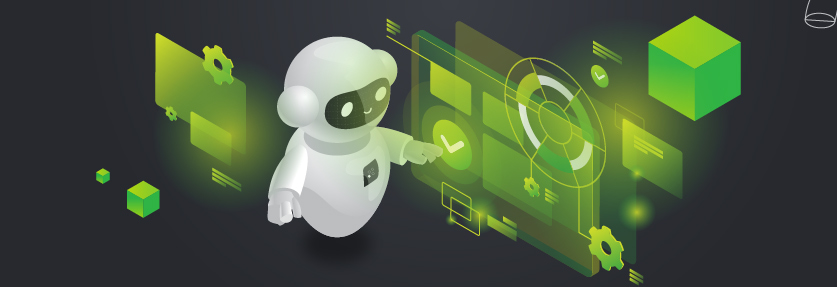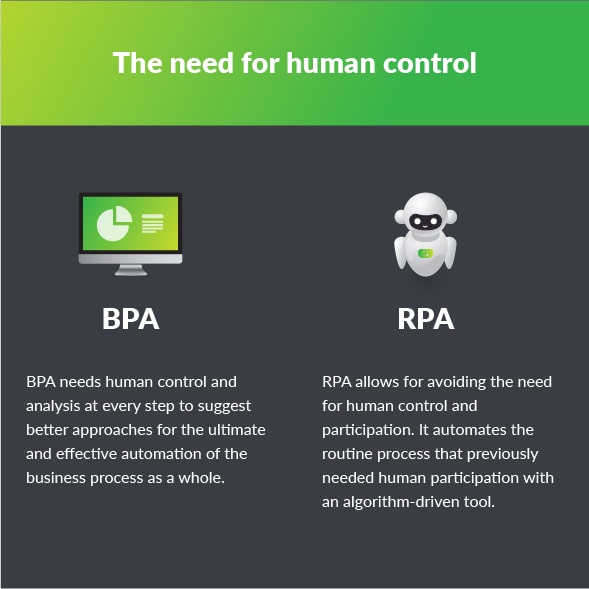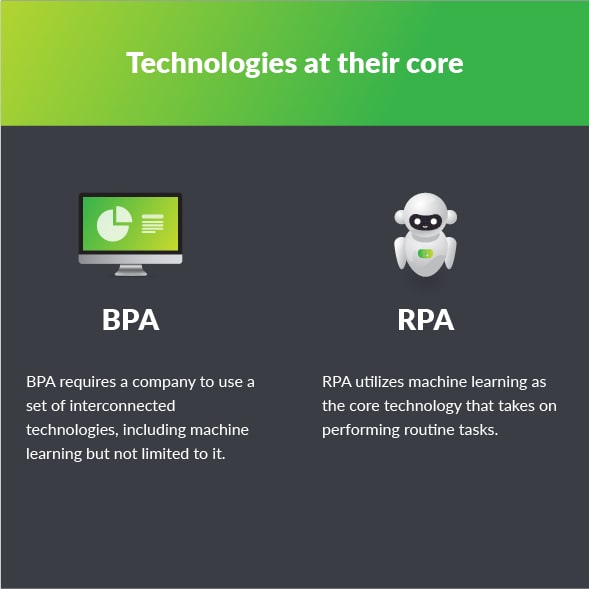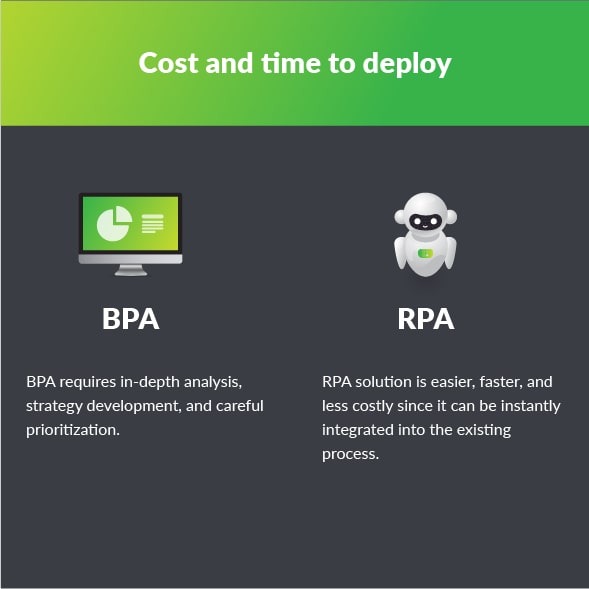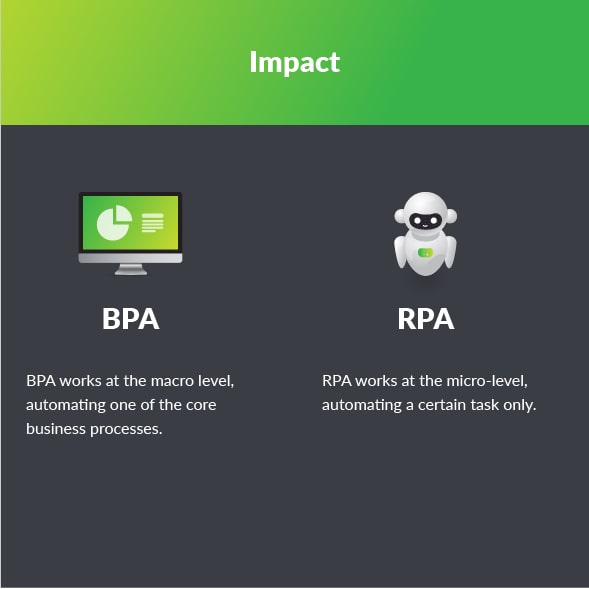RPA and BPA: Features of These Technologies, Similarities, and Differences
While 73% of companies globally have already implemented automation technologies into their workflows, there is still some confusion when it comes to defining some automation concepts and drawing a clear line between them. Both business process automation (BPA) and robotic process automation (RPA) have automation at their heart, but they are still not the same things. Let’s find out their definitions, similarities, and differences to better understand the value both of the approaches can deliver for your business.
- What Is Business Process Automation (BPA)?
- What Is Robotic Process Automation (RPA)?
- RPA and BPA Differences
- RPA and BPA Similarities
- The Benefits of Business and Robotic Process Automation
What Is Business Process Automation (BPA)?
Business process automation or BPA means using a set of technologies to streamline the set of activities or tasks the company performs to achieve a certain goal. Since a business process consists of several stages, tasks, and activities, business process automation is also often defined as a strategy to automate them step by step. Some of the tasks can be automated with the help of robotic process automation or RPA solutions, so explaining RPA in this context makes the most sense.
What Is Robotic Process Automation (RPA)?
Robotic process automation, in turn, means using robotic technologies (the combination of machinery and AI software) to automate a certain task within the business process. Robotic solutions are fueled by the data, programmed with the business logic in mind, and are algorithm-driven. These features make them effective for streamlining and automating routine tasks that don’t require human touch and creativity. For example, robotic process automation is used in banking (call center automation), agriculture (farming robots), and healthcare (robotic assistants).
RPA and BPA Differences
While both RPA and BPA are about automation, being related as a whole and a part, there are still several significant differences between them.
-
The need for human control
Business process automation isn’t an end result – this is the process of continuing integration of new software solutions and practices to improve a certain area. BPA is always about having a far-reaching strategy and goal which can be changed depending on the results obtained at the previous stage. That’s why implementing BPA as a strategy always needs human control and analysis at every step to suggest better approaches for the ultimate and effective automation of the business process as a whole.
Robotic process automation, in turn, allows for avoiding the need for human control and participation. This is the core idea behind robotic solutions – automate the routine process that previously needed human participation with an algorithm-driven tool.
-
Technologies at their core
Robotic process automation utilizes machine learning as the core technology that takes on performing routine tasks. But when it comes to automation of a business process as a whole, the companies usually use a set of interconnected technologies, including machine learning but not limited to it. For example, manufacturers use IoT solutions to automate the production process, while banks can use blockchain for smart contracts management.
-
Cost and time to deploy
Deploying an RPA solution is easier, faster, and less costly compared to automating a business process. An RPA tool can be integrated into the existing process almost instantly, while business process automation requires in-depth analysis, strategy development, and careful prioritization. From this perspective, deploying RPA software to get rid of repetitive and time-consuming tasks can be the first step towards business process automation.
-
Impact
The impact the organizations can expect from implementing BPA is larger compared to the impact RPA can deliver since BPA and RPA are working at different levels. While RPA works at the micro level, automating a certain task only, BPA works at the macro level, automating one of the core business processes.
RPA and BPA Similarities
Despite the differences, RPA and BPA have some similarities as well. Below are the features these technologies have in common.
-
Tech approach
Both RPA and BPA follow the same approach – they automate a certain task (RPA) and the whole business process (BPA) using the power of data analysis, machine learning, and AI decision-making.
-
Goal
Both RPA and BPA also have the same goal. They are aimed at improving efficiency, reducing operational costs, eliminating human mistakes, delivering better customer experience, improving productivity, and standardizing the task (RPA) and the process (BPA).
The Benefits of Business and Robotic Process Automation
| BPA and RPA Common Benefits | |
|---|---|
| Better efficiency. | This is the core goal of automation – increasing efficiency and productivity while reducing operational costs by replacing manual labor with smart software and equipment. |
| Fewer mistakes. | Automating business processes allows not only for dealing with both routine and more complex tasks with the help of software and advanced equipment. It also allows for making the process more standardized and transparent, reducing the number of mistakes and ensuring better compliance with the regulations. |
| Data-driven insights. | Utilizing BPA and RPA opens up the way for data collection and analysis, while the obtained insights can be used to develop the strategy of automating a certain process even more deeply and avoid the same mistakes when automating another one. |
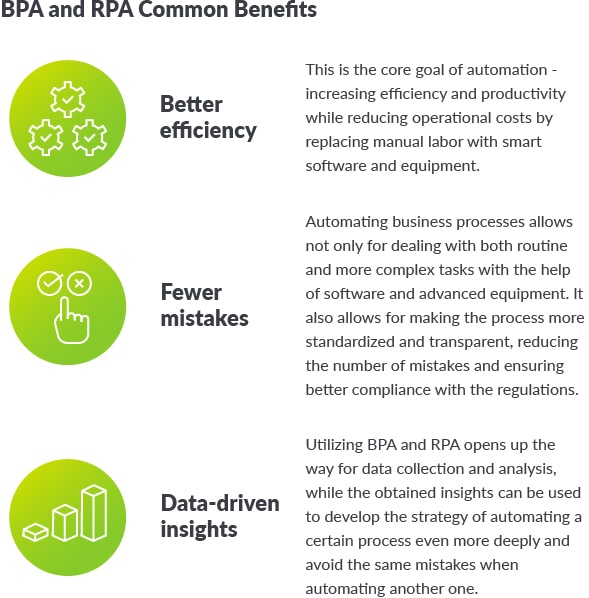
Conclusion
Both BPA and RPA are aimed at changing the way of performing everyday business tasks. While BPA stands for improving and automating the whole business process, robotic process automation is often its integral part.
